Benjamin Rosman
Make Haste Slowly: A Theory of Emergent Structured Mixed Selectivity in Feature Learning ReLU Networks
Mar 08, 2025Abstract:In spite of finite dimension ReLU neural networks being a consistent factor behind recent deep learning successes, a theory of feature learning in these models remains elusive. Currently, insightful theories still rely on assumptions including the linearity of the network computations, unstructured input data and architectural constraints such as infinite width or a single hidden layer. To begin to address this gap we establish an equivalence between ReLU networks and Gated Deep Linear Networks, and use their greater tractability to derive dynamics of learning. We then consider multiple variants of a core task reminiscent of multi-task learning or contextual control which requires both feature learning and nonlinearity. We make explicit that, for these tasks, the ReLU networks possess an inductive bias towards latent representations which are not strictly modular or disentangled but are still highly structured and reusable between contexts. This effect is amplified with the addition of more contexts and hidden layers. Thus, we take a step towards a theory of feature learning in finite ReLU networks and shed light on how structured mixed-selective latent representations can emerge due to a bias for node-reuse and learning speed.
Revisiting the Role of Relearning in Semantic Dementia
Mar 05, 2025Abstract:Patients with semantic dementia (SD) present with remarkably consistent atrophy of neurons in the anterior temporal lobe and behavioural impairments, such as graded loss of category knowledge. While relearning of lost knowledge has been shown in acute brain injuries such as stroke, it has not been widely supported in chronic cognitive diseases such as SD. Previous research has shown that deep linear artificial neural networks exhibit stages of semantic learning akin to humans. Here, we use a deep linear network to test the hypothesis that relearning during disease progression rather than particular atrophy cause the specific behavioural patterns associated with SD. After training the network to generate the common semantic features of various hierarchically organised objects, neurons are successively deleted to mimic atrophy while retraining the model. The model with relearning and deleted neurons reproduced errors specific to SD, including prototyping errors and cross-category confusions. This suggests that relearning is necessary for artificial neural networks to reproduce the behavioural patterns associated with SD in the absence of \textit{output} non-linearities. Our results support a theory of SD progression that results from continuous relearning of lost information. Future research should revisit the role of relearning as a contributing factor to cognitive diseases.
The Esethu Framework: Reimagining Sustainable Dataset Governance and Curation for Low-Resource Languages
Feb 21, 2025Abstract:This paper presents the Esethu Framework, a sustainable data curation framework specifically designed to empower local communities and ensure equitable benefit-sharing from their linguistic resources. This framework is supported by the Esethu license, a novel community-centric data license. As a proof of concept, we introduce the Vuk'uzenzele isiXhosa Speech Dataset (ViXSD), an open-source corpus developed under the Esethu Framework and License. The dataset, containing read speech from native isiXhosa speakers enriched with demographic and linguistic metadata, demonstrates how community-driven licensing and curation principles can bridge resource gaps in automatic speech recognition (ASR) for African languages while safeguarding the interests of data creators. We describe the framework guiding dataset development, outline the Esethu license provisions, present the methodology for ViXSD, and present ASR experiments validating ViXSD's usability in building and refining voice-driven applications for isiXhosa.
The Zeno's Paradox of `Low-Resource' Languages
Oct 28, 2024



Abstract:The disparity in the languages commonly studied in Natural Language Processing (NLP) is typically reflected by referring to languages as low vs high-resourced. However, there is limited consensus on what exactly qualifies as a `low-resource language.' To understand how NLP papers define and study `low resource' languages, we qualitatively analyzed 150 papers from the ACL Anthology and popular speech-processing conferences that mention the keyword `low-resource.' Based on our analysis, we show how several interacting axes contribute to `low-resourcedness' of a language and why that makes it difficult to track progress for each individual language. We hope our work (1) elicits explicit definitions of the terminology when it is used in papers and (2) provides grounding for the different axes to consider when connoting a language as low-resource.
InkubaLM: A small language model for low-resource African languages
Sep 03, 2024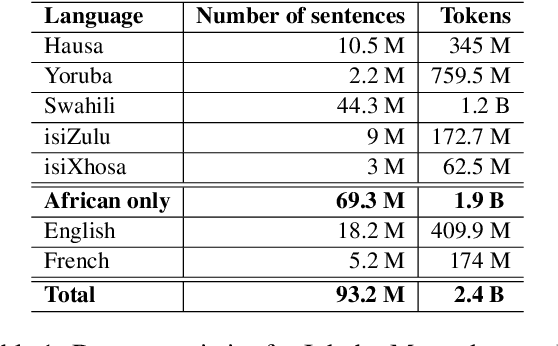
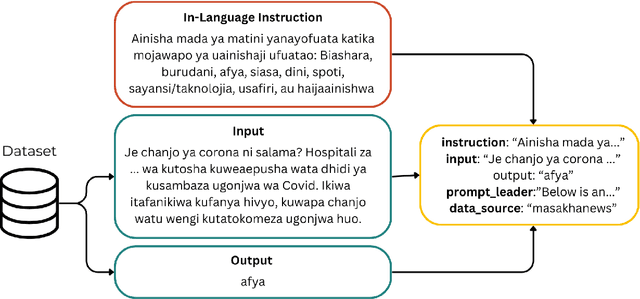
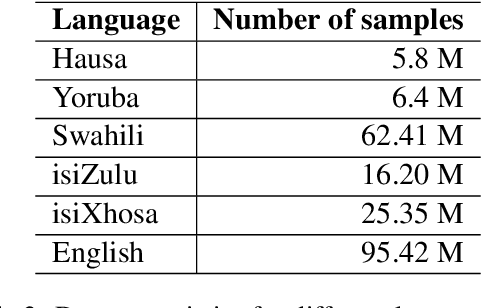
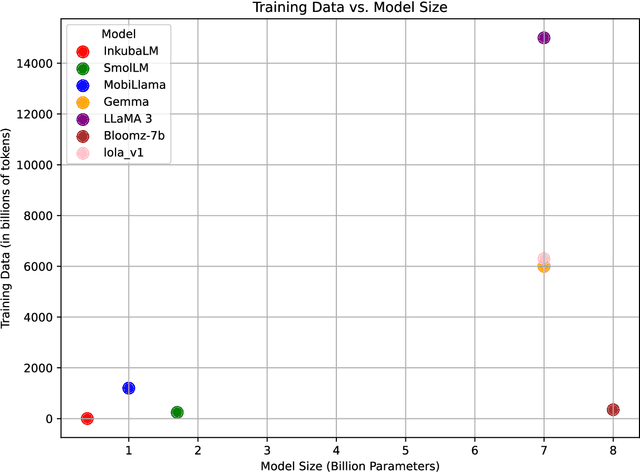
Abstract:High-resource language models often fall short in the African context, where there is a critical need for models that are efficient, accessible, and locally relevant, even amidst significant computing and data constraints. This paper introduces InkubaLM, a small language model with 0.4 billion parameters, which achieves performance comparable to models with significantly larger parameter counts and more extensive training data on tasks such as machine translation, question-answering, AfriMMLU, and the AfriXnli task. Notably, InkubaLM outperforms many larger models in sentiment analysis and demonstrates remarkable consistency across multiple languages. This work represents a pivotal advancement in challenging the conventional paradigm that effective language models must rely on substantial resources. Our model and datasets are publicly available at https://huggingface.co/lelapa to encourage research and development on low-resource languages.
Multi-State-Action Tokenisation in Decision Transformers for Multi-Discrete Action Spaces
Jul 01, 2024Abstract:Decision Transformers, in their vanilla form, struggle to perform on image-based environments with multi-discrete action spaces. Although enhanced Decision Transformer architectures have been developed to improve performance, these methods have not specifically addressed this problem of multi-discrete action spaces which hampers existing Decision Transformer architectures from learning good representations. To mitigate this, we propose Multi-State Action Tokenisation (M-SAT), an approach for tokenising actions in multi-discrete action spaces that enhances the model's performance in such environments. Our approach involves two key changes: disentangling actions to the individual action level and tokenising the actions with auxiliary state information. These two key changes also improve individual action level interpretability and visibility within the attention layers. We demonstrate the performance gains of M-SAT on challenging ViZDoom environments with multi-discrete action spaces and image-based state spaces, including the Deadly Corridor and My Way Home scenarios, where M-SAT outperforms the baseline Decision Transformer without any additional data or heavy computational overheads. Additionally, we find that removing positional encoding does not adversely affect M-SAT's performance and, in some cases, even improves it.
Towards Financially Inclusive Credit Products Through Financial Time Series Clustering
Feb 16, 2024Abstract:Financial inclusion ensures that individuals have access to financial products and services that meet their needs. As a key contributing factor to economic growth and investment opportunity, financial inclusion increases consumer spending and consequently business development. It has been shown that institutions are more profitable when they provide marginalised social groups access to financial services. Customer segmentation based on consumer transaction data is a well-known strategy used to promote financial inclusion. While the required data is available to modern institutions, the challenge remains that segment annotations are usually difficult and/or expensive to obtain. This prevents the usage of time series classification models for customer segmentation based on domain expert knowledge. As a result, clustering is an attractive alternative to partition customers into homogeneous groups based on the spending behaviour encoded within their transaction data. In this paper, we present a solution to one of the key challenges preventing modern financial institutions from providing financially inclusive credit, savings and insurance products: the inability to understand consumer financial behaviour, and hence risk, without the introduction of restrictive conventional credit scoring techniques. We present a novel time series clustering algorithm that allows institutions to understand the financial behaviour of their customers. This enables unique product offerings to be provided based on the needs of the customer, without reliance on restrictive credit practices.
Counting Reward Automata: Sample Efficient Reinforcement Learning Through the Exploitation of Reward Function Structure
Dec 18, 2023Abstract:We present counting reward automata-a finite state machine variant capable of modelling any reward function expressible as a formal language. Unlike previous approaches, which are limited to the expression of tasks as regular languages, our framework allows for tasks described by unrestricted grammars. We prove that an agent equipped with such an abstract machine is able to solve a larger set of tasks than those utilising current approaches. We show that this increase in expressive power does not come at the cost of increased automaton complexity. A selection of learning algorithms are presented which exploit automaton structure to improve sample efficiency. We show that the state machines required in our formulation can be specified from natural language task descriptions using large language models. Empirical results demonstrate that our method outperforms competing approaches in terms of sample efficiency, automaton complexity, and task completion.
Generalisable Agents for Neural Network Optimisation
Nov 30, 2023Abstract:Optimising deep neural networks is a challenging task due to complex training dynamics, high computational requirements, and long training times. To address this difficulty, we propose the framework of Generalisable Agents for Neural Network Optimisation (GANNO) -- a multi-agent reinforcement learning (MARL) approach that learns to improve neural network optimisation by dynamically and responsively scheduling hyperparameters during training. GANNO utilises an agent per layer that observes localised network dynamics and accordingly takes actions to adjust these dynamics at a layerwise level to collectively improve global performance. In this paper, we use GANNO to control the layerwise learning rate and show that the framework can yield useful and responsive schedules that are competitive with handcrafted heuristics. Furthermore, GANNO is shown to perform robustly across a wide variety of unseen initial conditions, and can successfully generalise to harder problems than it was trained on. Our work presents an overview of the opportunities that this paradigm offers for training neural networks, along with key challenges that remain to be overcome.
Dynamics Generalisation in Reinforcement Learning via Adaptive Context-Aware Policies
Oct 25, 2023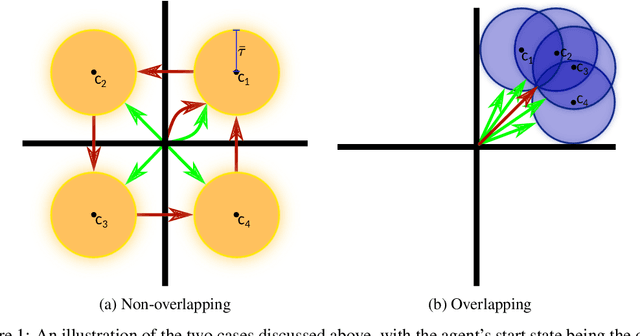
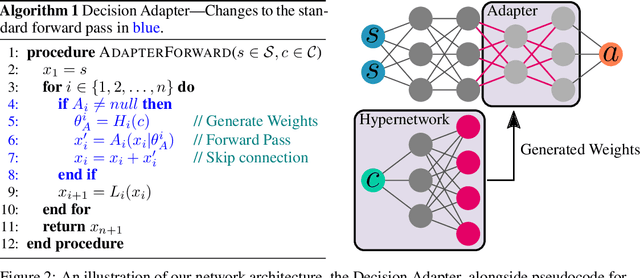
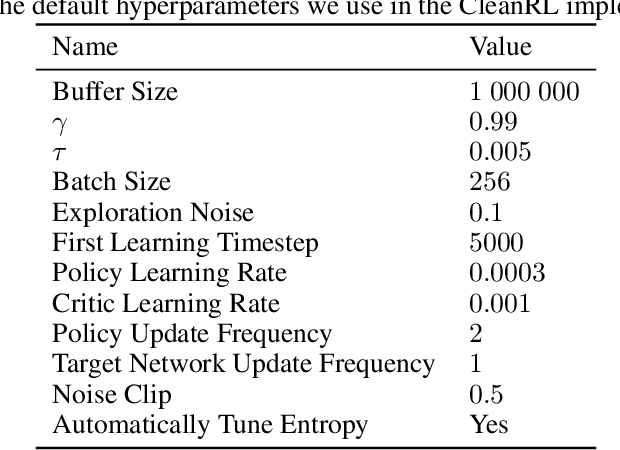

Abstract:While reinforcement learning has achieved remarkable successes in several domains, its real-world application is limited due to many methods failing to generalise to unfamiliar conditions. In this work, we consider the problem of generalising to new transition dynamics, corresponding to cases in which the environment's response to the agent's actions differs. For example, the gravitational force exerted on a robot depends on its mass and changes the robot's mobility. Consequently, in such cases, it is necessary to condition an agent's actions on extrinsic state information and pertinent contextual information reflecting how the environment responds. While the need for context-sensitive policies has been established, the manner in which context is incorporated architecturally has received less attention. Thus, in this work, we present an investigation into how context information should be incorporated into behaviour learning to improve generalisation. To this end, we introduce a neural network architecture, the Decision Adapter, which generates the weights of an adapter module and conditions the behaviour of an agent on the context information. We show that the Decision Adapter is a useful generalisation of a previously proposed architecture and empirically demonstrate that it results in superior generalisation performance compared to previous approaches in several environments. Beyond this, the Decision Adapter is more robust to irrelevant distractor variables than several alternative methods.
 Add to Chrome
Add to Chrome Add to Firefox
Add to Firefox Add to Edge
Add to Edge